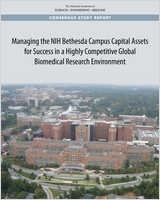NCBI Bookshelf. A service of the National Library of Medicine, National Institutes of Health.
The National Institutes of Health (NIH) is the primary agency of the United States government responsible for biomedical and public health research. Founded in the late 1870s, NIH has produced extraordinary advances in the treatment of common and rare diseases and leads the world in biomedical research. It is a critical national resource that plays an important role in supporting national security. The 310-acre Bethesda campus supports some 20,000 employees and contractors, and it contains more than 12 million square feet of facilities divided amongst nearly 100 buildings, including the largest dedicated research hospital in the world. The Bethesda campus supports some of the most sophisticated and groundbreaking biomedical research in the world. However, while some new state-of-the-art buildings have been constructed in recent years, essential maintenance for many facilities and the campus overall has been consistently deferred for many years. The deteriorating condition of NIH's built environment is now putting its ability to fulfill its mission at substantial risk. Managing the NIH Bethesda Campus's Capital Assets for Success in a Highly Competitive Global Biomedical Research Environment identifies the facilities in greatest need of repair on the Bethesda campus and evaluates cost estimates to determine what investment is needed for the NIH to successfully accomplish its mission going forward.
Contents
- The National Academies of SCIENCES • ENGINEERING • MEDICINE
- COMMITTEE ON ASSESSING THE CAPITAL NEEDS OF THE NATIONAL INSTITUTES OF HEALTH
- BOARD ON INFRASTRUCTURE AND THE CONSTRUCTED ENVIRONMENT
- Preface
- Acknowledgment of Reviewers
- Summary
- INTRODUCTION
- NIH BETHESDA CAMPUS: FACILITIES AND ACTIVITIES
- CURRENT CONDITIONS
- CURRENT CAPITAL ASSET MANAGEMENT AT NIH
- NIH APPROACH TO MANAGING ITS BETHESDA CAMPUS BUILDINGS AND FACILITIES
- FUTURE NIH APPROACH TO PLANNING
- THE EVOLVING GLOBAL BIOMEDICAL RESEARCH ENVIRONMENT: IMPLICATIONS FOR NIH AND ITS CAPITAL ASSETS
- CONCLUSION
- 1. Introduction
- 2. Global and National Biomedical Research Environment
- 3. NIH Bethesda Campus: Facilities and Activities
- 4. Current Condition
- 5. Current Capital Asset Management at NIH
- 6. NIH Current Approach to Strategic Planning for the Bethesda Campus Buildings and Facilities
- 7. The Future of Capital Planning for the NIH Bethesda Campus
- 8. The Evolving Global Biomedical Research Environment and Its Implications for NIH Capital Assets
- 9. Recommendations
- References
- A. Statement of Task
- B. Committee Biographical Information
- C. Committee Activities
- D. Data on NIH Clinical Center
- E. NIH Facilities: Cores
- F. Facilities on Bethesda Campus
- G. NIH Facilities: Space Utilization
- H. Review of NIH Corporate Strategic Planning Process
- I. Capital Asset Portfolio Performance-Based Capital Planning Decision Making
- J. Glossary
- K. Acronyms
Suggested citation:
National Academies of Sciences, Engineering, and Medicine. 2019. Managing the NIH Bethesda Campus Capital Assets for Success in a Highly Competitive Global Biomedical Research Environment. Washington, DC: The National Academies Press. doi: https://doi.org/10.17226/25483.
Digital Object Identifier: https://doi.org/10.17226/25483
Front cover: Aerial photograph of the NIH Clinical Center, 2014. Courtesy of the Office of NIH History and the Stetten Museum. Back cover: Aerial photograph of the NIH Bethesda Campus. Courtesy of the National Institutes of Health.
Additional copies of this publication are available for sale from the National Academies Press, 500 Fifth Street, NW, Keck 360, Washington, DC 20001; (800) 624-6242 or (202) 334-3313; http://www.nap.edu.
Printed in the United States of America
- NLM CatalogRelated NLM Catalog Entries
- Activities of the National Institutes of Health relating to energy efficiency and pollution prevention.[Environ Health Perspect. 2000]Activities of the National Institutes of Health relating to energy efficiency and pollution prevention.Ficca SA, Chyun YD, Ebrahimi M, Kutlak F, Memarzadeh F. Environ Health Perspect. 2000 Dec; 108 Suppl 6(Suppl 6):939-44.
- The development of the intramural research program at the National Institutes of Health after World War II.[Perspect Biol Med. 2003]The development of the intramural research program at the National Institutes of Health after World War II.Park BS. Perspect Biol Med. 2003 Summer; 46(3):383-402.
- Coauthor Country Affiliations in International Collaborative Research Funded by the US National Institutes of Health, 2009 to 2017.[JAMA Netw Open. 2019]Coauthor Country Affiliations in International Collaborative Research Funded by the US National Institutes of Health, 2009 to 2017.Grubbs JC, Glass RI, Kilmarx PH. JAMA Netw Open. 2019 Nov 1; 2(11):e1915989. Epub 2019 Nov 1.
- Review Culture of Care: Organizational Responsibilities.[Management of Animal Care and ...]Review Culture of Care: Organizational Responsibilities.Brown MJ, Symonowicz C, Medina LV, Bratcher NA, Buckmaster CA, Klein H, Anderson LC. Management of Animal Care and Use Programs in Research, Education, and Testing. 2018
- Review Tuberculosis.[Major Infectious Diseases. 2017]Review Tuberculosis.Bloom BR, Atun R, Cohen T, Dye C, Fraser H, Gomez GB, Knight G, Murray M, Nardell E, Rubin E, et al. Major Infectious Diseases. 2017 Nov 3
- Managing the NIH Bethesda Campus Capital Assets for Success in a Highly Competit...Managing the NIH Bethesda Campus Capital Assets for Success in a Highly Competitive Global Biomedical Research Environment
Your browsing activity is empty.
Activity recording is turned off.
See more...
